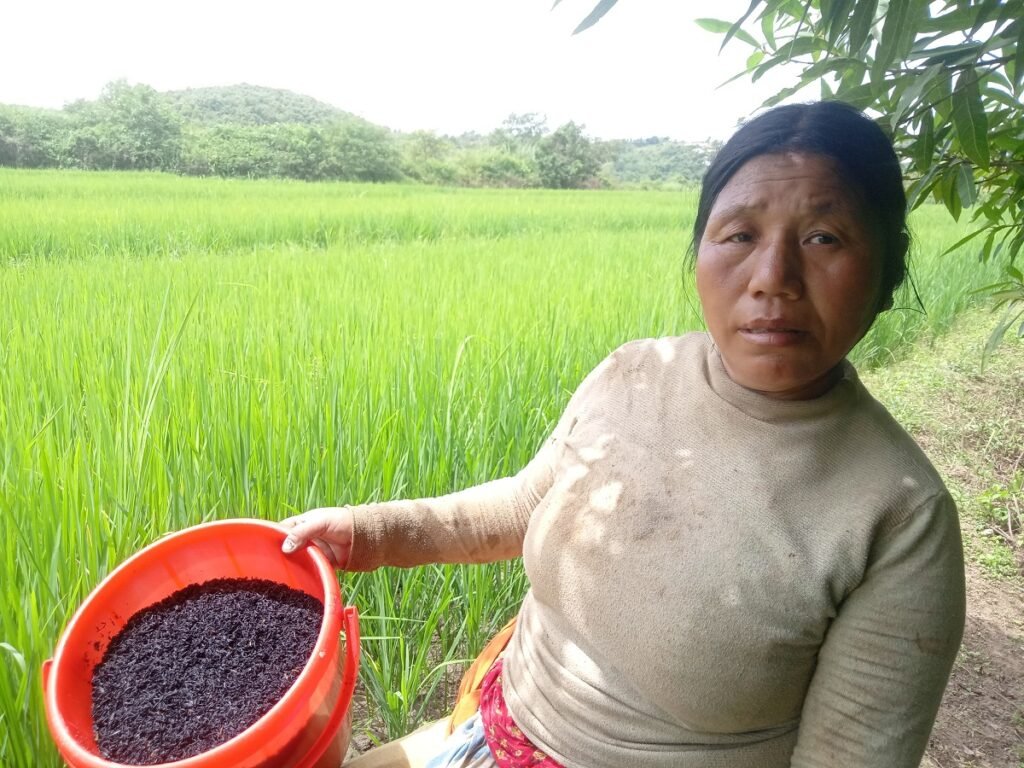Rice husk is a significant byproduct of rice cultivation in Manipur, India, where rice is a staple food. Kharif harvesting has resulted in significant environmental pollution in and around the local rice mills located both in urban and rural areas.
In response to this issue, around 1986, Dr. Naorem Iboton and Dr. Tombisana from the Department of Plant Pathology at what was then Manipur Agricultural College (now The Central Agricultural University), Iroisemba, conducted research leading to the discovery of the potential benefits of utilizing rice husk in agricultural crops.
Over a span of 2-3 years, their research initiative involved training more than four thousand women farmers on the application and medicinal value of rice husk. Subsequently, these farmers adopted the use of rice husk as a primary component in cultivating rice and potatoes. This shift resulted in bumper harvests and a substantial reduction in local pollution.
During the 19th century, charcoal dust rhizobium biofertilizers were commonplace in agriculture, leading to extensive deforestation. In a pioneering move in 1986, rice husk, burned to a black-colored char, was introduced as an alternative carrier material for biofertilizers, known as Silicon-based Biofertilizers or Biochar, in Manipur, India.
Pure cultures of Rhizobium, Azotobacter, and Azospirillum spp. were grown in suitable culture media and then mixed with fresh black-colored rice husks. The biofertilizers were left for 7 days at 26 to 29 degrees Celsius before application. The resulting biofertilizers, known as Silicon-based Biofertilizers or Biochar, contained silicon, which is naturally present in rice husk.
To apply the biofertilizers, silica-based Azospirillum was dropped onto the water surface of rice fields one day after transplanting or direct sowing. The second and third doses were given during the tillering and panicle initiation stages. This increased plant growth and development, resulting in maximum grains/panicles. Rice plants also received nitrogen and silica during their normal growth stages, which reduced pressure from diseases and pests. Farmers who used this method felt fully satisfied with the optimum rice yield of 5 tonnes per hectare as compared to conventional methods.
The use of silicon-based Azotobacter has been successful in growing non-leguminous crops such as chili, tomato, brinjal, potato, pumpkin, and gourd. Farmers have reported healthy growth and optimal yields while spending less than they would using conventional methods with chemical fertilizers and pesticides.
It is also surprising to see the bright appearance of freshly harvested potato tuber skins from plants that only received silicon-based Azotobacter. Additionally, applying silicon-based Azotobacter (at half a handful of biofertilizers per heel/egg-sized tuber) can protect against powdery scabs, common scabs, and black scurf in potato crops.
Potato-growing farmers in Kakching have interacted with Dr. Iboton regarding the significant loss of more than 70% of their seed potatoes under traditional storage methods due to mite and mealy bug infestation with wrinkled tubers or long, lanky sprouts.
Drawing from their research findings, Dr. Iboton and Dr. Sumarjit provided valuable advice to these farmers, recommending the use of rice husk for storing seed potatoes, ginger, and turmeric rhizomes. This strategic shift in storage methods has proven effective in preserving the quality of seed potatoes and mitigating the losses incurred under traditional storage practices.
For storing seed potatoes, farmers should arrange a paper carton box with a 20 kg capacity, along with high-quality potato tubers smaller than chicken egg size, and some binding thread. To initiate the method, a 2-inch layer of rice husk should be evenly spread at the bottom of the carton box. Subsequently, the seed potatoes are placed on top of this layer, and another 2-inch thick layer of rice husk is poured over them. This layering process is repeated until the carton box is completely filled, ensuring the topmost part is covered with a final layer of rice husk.
The next step involves securely covering the box and binding it with the thread. For the final stage, these boxes, each containing seed tubers, should be arranged on wooden planks in a vertical position (typically 4-5 boxes) and kept under shade for a duration of 5-6 months. This method, employing rice husk as a storage medium, has proven effective in preserving the quality of seed potatoes.
Moreover, the application of silicon-based Azotobacter is now recognized as an effective remedy for potato crops, leading farmers to cultivate over five thousand hectares with this method. With two applications, one at sowing and another just after the first earthling stage (3-4 leaves stage), farmers using silicon-based Azotobacter are achieving yields of more than 8 tonnes per hectare.
Rice husk can also be used as an aphid attractant/repellant. When used as mulching material or kept in small heaps within the potato field, the bright golden color of rice husk, when hit by sunlight, attracts/repels potato aphids, Myzus persicae, vector of PVA, PVA+PVX, and leaf rot, respectively.
Beyond agriculture, it can also be utilised as raw materials for making plate cups, tiles, silica gel, insulators, paper, briquettes, etc by setting respective industries which can provide employment to enormous youths around the world.
The demand for rice husks is steadily increasing, mitigating environmental pollution concerns. The success of this organic farming method in rice-growing countries like India, China, Myanmar, Thailand, Laos, the Philippines, and other Southeast Asian nations highlights its potential for enhancing food security and environmental sustainability.
For those seeking details on rice husk biochar preparation, contact Dr. Naorem Iboton Singh, Retired Prof, and Dean at the Central Agricultural University, Imphal, India, and Chief Advisor of Green Foundation, Imphal, at iboton.naorem@gmail.com. Embracing this technology is not only crucial for food security but also contributes to environmental safety.

